Can we look bee colonies as biological indicators of forest ecosystem? A comparative study of the occurrence of bee colonies in some protected areas of Rajasthan, India
DOI:
https://doi.org/10.36808/if/2022/v148i8/160593Keywords:
Honeybee, biological indicators, protected areas, large treesAbstract
Survey of colonies of Apis dorsata was conducted in five reserves, including Keoladeo national park (KNP), Jhalana leopard reserve (JLR), Sariska tiger reserve (STR), Sitamata wildlife sanctuary (SWS), Bassi wildlife sanctuary (BWS), located in semi-arid landscape of Rajasthan. Bee colonies were observed mostly on medium to large sized trees in the study areas demonstrating the role of size of trees irrespective of species type. The observation of high density of bee colonies in KNP (d = 7.1 colonies/km²) can be attributed to low intensity of anthropogenic pressures that is evident from low PIPUA (p' = 1.68). In contrast observation of low density of bee colonies in STR and SWS (d = 0.2, 0.1 colonies/km²) can be attributed to high anthropogenic interferences which is evident from the observation of high PIPUA (p' = 8.04, 8.08 respectively). Thus, the bee colonies can be considered as biological indicator of forest ecosystem.References
Aizen M.A. and Feinsinger P. (1994). Habitat fragmentation, native insect pollinators and feral honey bees in Argentine 'Chaco Serrano'. Ecological Applications, 4: 378–392.
Anon. (2005). Harvest of Wild Honey. Int. Workshop Ecol. Mont. Prot. Auroville, T.N, India. pp. 93-94.
Anon. (2007). Apiculture in India. Current Science, 92(10): 1336.
Basavarajappa S. (1998). Status of natural colonies of Apis dorsata in Maidan region of Karnataka. Indian Bee Journal, 60(3): 143-146.
Bhardwaj G.S. (2018). Sariska Tiger Reserve: A managerial approach to the problems of landscape. Indian Forester, 144(10): 900-910.
Bhardwaj G.S. and A. Kumar (2019). The Comparison of shape indices and perimeter interface of selected protected areas especially with reference to Sariska Tiger Reserve. Global Ecology and Conservation, 17, e00504
Bhardwaj G.S., Selvi G., Agasti S., Singh H., Kumar A. and Reddy G.V. (2020). A survey on demonstrating patterns of Apis dorsatacolonization in Sariska Tiger Reserve, Rajasthan.
Indian Forester, 146(8): 682-587, 2020, DOI: 10.36808/if/2020/v146i8/154146
Blanche K.R., Ludwig J.A. and Cunningham S.A. (2006). Proximity to rainforest enhances pollination and fruit set in orchards. Journal of Applied Ecology, 43: 1182–1187.
Brodschneider R. and Crailsheim K. (2010). Nutrition and health in honey bees. Apidologie, 41: 278–294.
Champion H.G. and Seth S.K. (1968). A revised survey of the forest type of India. Government of India Press, Delhi, pp. 404 Couvillon Margaret J. and Ratneiks and Francis L.W. (2015).
Environmental consultancy: dancing bee bioindicators to evaluate “landscape health”. Frontiers in Ecology and Evolution, 3: 44
Dyer F.C. and Seeley T.D. (1994). Colony migration in the tropical honey bee Apis dorsata F. (Hymenoptera: Apidae). Insects Soc., 41: 129-140
Eischen F.A. and Graham R.H. (2008). Feeding overwintering honey bee colonies infected with Nosema ceranae, In: Proceedings of the American Bee Research Conference. Am. Bee J. , 148: 555.
Engel M.S. (2012). The Honey bee of Indonesia (Hymenoptera: Apidae). Treubia, 39: 41-49
Fortuna M.A. and Bascompte J. (2006). Habitat loss and the structure of plant-animal mutualistic networks. Ecology Letters, 9(3): 281–286.
Gupta R.K. (2014). Taxonomy and distribution of different honeybee species. In: Gupta R.K., Reybroeck W., van Veen J.W. and Gupta A. (eds): Beekeeping for poverty alleviation and livelihood security Vol.1: Technological aspects of beekeeping. Pp. 63–103
Harris L.F. and Johnson S.D. (2004). The consequences of habitat fragmentation for plant-pollinator mutualisms. International Journal of Tropical Insect Science, 24: 29–43.
Liu J., Li Y., Zhang B., Cao J., Cao Z. and Domagalski J. (2009). Ecological risk of heavy metals in sediments of the Luan River source water. Ecotoxicology, 18, 748-758
Naug D. (2009). Nutritional stress due to habitat loss may explain recent honeybee colony collapses. Biological Conservation, 142: 2369–2372. 10.1016/j.biocon.2009.04.007
Oldroyd B.P., Osborne K.E. and Mardan M. (2000). Colony relatedness in aggregations of Apis dorsata F. (Hymenoptera: Apidae). Insects Soc., 47: 94-95.
Porrini C., Ghinni S., Girotti S., Sabatini A.G., Gattavechia E. and Celli G. (2002). Use honey bees as bio-indicators of environmental pollution in Italy. In: Honey Bees: Estimating the Environmental Impact of Chemicals.
Devillers J. and PhamDelègue M. (Eds).Taylor and Francis, London and New York: 186-247.
Ricketts T.H. (2004). Tropical forest fragments enhance pollinator activity in nearby coffee crops. Conservation Biology, 18: 1262–1271.
Ricketts T.H., Regetz J., Steffan Dewenter I., Cunningham S.A., Kremen C., Bogdanski A. and Viana B.F. (2008). Landscape effects on crop pollination services: Are there general patterns? Ecology Letters, 11: 499–515.
Reddy M.S. and Reddy C.C. (1989). Height-dependent nest site selection in Apis dorsata Fab. Indian Bee Journal, 51(3): 105-106.
Reddy C.C. (2002). Bee keeping policies and programs in India. 6thAAA Inter. Con. & World Apiexpo. February2-March 1, 2002, Bangalore-India. P.03.
Rodgers W.A. and Panwar H.S. (1988). Planing a wildlife protected area network in India Vol. I and II Wildlife Institute of Dehradun.
Roman A. (2010). Level of copper, selenium, lead and cadmium in forager bees. Polish journal of environmental studies, 19(3):663-669.
Senapathi D., Carvalheiro L.G., Biesmeijer J.C., Dodson C.A., Evans R.L., McKerchar M., Morton R.D., Moss E.D., Roberts
S.P., Kunin W.E. and Potts S.G. (2015). The impact of over 80 years of land cover changes on bee and wasp pollinator communities in England. Proc Biol Sci., 2015 May 7; 282(1806): 20150294.
Sharma S.K. (2007). Study of Biodiversiy and Ethnobiology of Phulwari Wildlife Sanctuary, Udaipur, Rajasthan (Vol II). Ph D Thesis submitted to Deptt of Botany, University College of Science, Mohanlal Sukharia University.
Singh H. and Dookia S. (2016). What would happen if bees went extinct? Honey Bee Conservation. In 19th Indian Birding Fair, 5-6 February, 2016, Jaipur.
Downloads
Downloads
Published
How to Cite
Issue
Section
License
Unless otherwise stated, copyright or similar rights in all materials presented on the site, including graphical images, are owned by Indian Forester.





